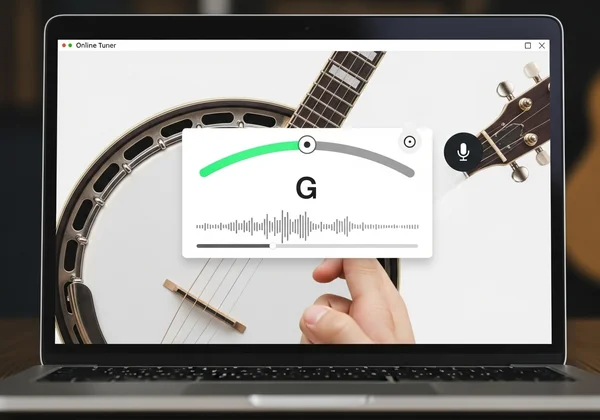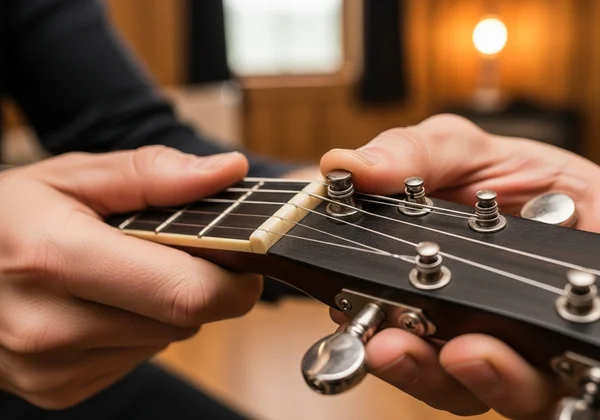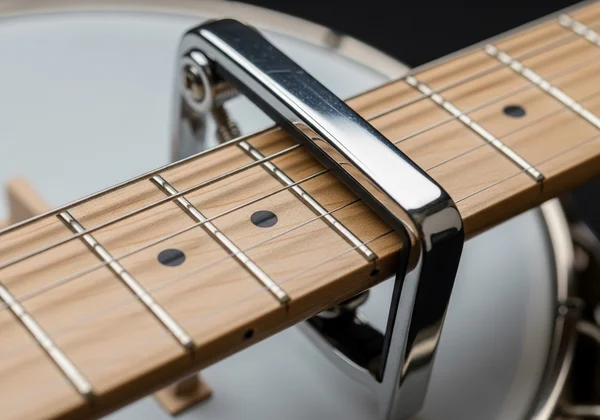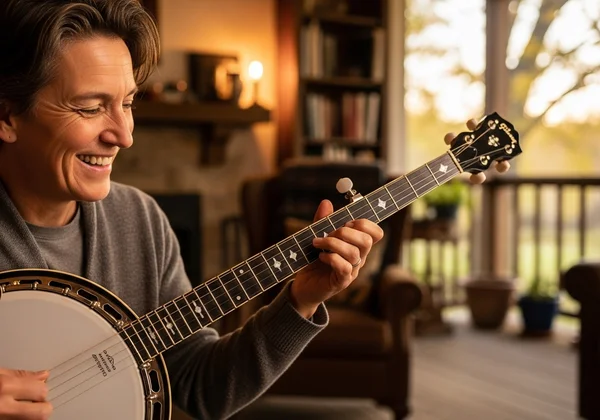Tune Your Banjo Online: A Beginner's Guide to G, C, & D Tunings
Ready to pluck that classic, twangy sound from your new banjo? Mastering this iconic instrument begins with one crucial step: getting it in tune. For beginners, the unique 5-string setup and various tunings can seem daunting. This guide is here to simplify the process. We’ll walk you through the essentials, from the standard Open G to popular alternatives like C and D tunings. How to tune a banjo online? The answer is simpler than you think with a reliable banjo tuner. Discover how our free online tuner makes precise tuning easy, ensuring your banjo always sounds its best.
Understanding Banjo Tuning Essentials
Before you start turning any pegs, it's helpful to understand a few basics about the 5-string banjo. Unlike a guitar, its anatomy and tuning logic have some unique quirks. Getting familiar with these fundamentals will make the process much smoother and help you tune with confidence. Using a free online tuner makes this process visual and straightforward, even for absolute beginners.
The Unique 5-String Banjo & Its Tuning Pegs
The most distinct feature of a standard banjo is its fifth string, often called the "drone" string. It is shorter than the other four and has its tuning peg located on the side of the neck, usually around the 5th fret. This string produces a high, constant note that gives the banjo its signature sound. The other four pegs are on the headstock, similar to a guitar. Knowing which peg controls which string is the first step to successful tuning.
Why Accurate Tuning Matters for Banjo Players
Playing an out-of-tune instrument is frustrating for both the player and the listener. For beginners, accurate tuning is even more critical. It helps develop your ear, ensures the chords you learn sound correct, and makes your practice sessions much more rewarding. An instrument that is perfectly in tune produces a resonant and pleasing sound, motivating you to pick it up and play more often. Every note will ring true, making your musical journey enjoyable from the start.
Getting Started with Your Free Online Banjo Tuner
Forget expensive clip-on tuners or confusing apps. An online banjo tuner is the most accessible tool for any musician. To get started with our tuning tool, you only need your banjo and a device with a microphone, like a laptop or smartphone. Simply visit our homepage, grant microphone access when prompted by your browser, and you're ready. The interface will provide instant visual feedback, showing you if your string is flat (too low), sharp (too high), or perfectly in tune. It’s an intuitive and completely free way to get a professional-level tuning.

How to Tune a Banjo to Standard Open G Tuning (gDGBD)
The most common and versatile tuning for the 5-string banjo is Open G. This tuning is used in countless bluegrass, folk, and country songs. When you strum the open strings in this tuning, you hear a G major chord, which is why it's called "Open G." The notes, from the 5th string to the 1st, are g-D-G-B-D. The lowercase 'g' represents the high G of the short 5th string.
Step-by-Step Guide for Open G Tuning
Follow this open G tuning guide to get your banjo ready to play. Pluck one string at a time and watch the feedback from our online instrument tuner. Adjust the corresponding tuning peg until the indicator shows the correct note and is centered perfectly.
- 5th String (The Short One): This is the highest string. Pluck it and adjust its peg (on the neck) until the tuner shows a perfect g.
- 4th String: This is the lowest-pitched string. Pluck it and adjust its peg on the headstock until the tuner shows D.
- 3rd String: Pluck this string and adjust its peg until the tuner reads G. This G is an octave lower than the 5th string.
- 2nd String: Pluck this string and adjust its peg until you see a perfect B on the tuner.
- 1st String: This is the string closest to the floor. Pluck it and adjust its peg until the tuner reads D, the same note as the 4th string but an octave higher.
Once all strings are tuned, strum them together. You should hear a bright, full G major chord. It’s always a good idea to go through the strings a second time, as adjusting one can slightly affect the tension of the others.

Common Challenges in Open G & Quick Fixes
Even with a great tuner, beginners can face a few hurdles. New strings, for example, tend to stretch and go out of tune quickly. Be prepared to re-tune frequently during the first few days after changing them. If you hear a buzzing sound, one of the strings might be vibrating against a fret; ensure you are pressing down firmly or check if your banjo’s setup (action) needs adjustment. Following these banjo tuning steps consistently will help you quickly identify and solve these minor issues.
Exploring Other Popular 5-String Banjo Tunings: C & D
While Open G is the standard, exploring 5 string banjo tuning alternatives can unlock new sounds and styles. Many folk and old-time tunes use different tunings to create unique moods and make certain melodies easier to play. Our chromatic tuner can handle any tuning you throw at it, making experimentation fun and easy.

Tuning Your Banjo to C Tuning (gCGBD)
Often called "Drop C" tuning, this variation is common in old-time and clawhammer banjo styles. It offers a deeper, more mellow sound compared to Open G. To switch from Open G to C tuning, you only need to adjust one string.
To get into C tuning for banjo, start from the standard Open G (gDGBD) tuning. Then, lower the pitch of your 4th string from D down to a C. The final tuning will be g-C-G-B-D. This small change gives chords a completely different feel and is perfect for accompanying singers in the key of C.
Tuning Your Banjo to D Tuning (aDGBD or aDADE)
D tuning is another classic favored by legends like Earl Scruggs. It's fantastic for playing fiddle tunes and has a bright, cheerful quality. There are a couple of popular variations of D tuning.
One common method to achieve a D tuning banjo sound is to start in Open G and place a capo on the 2nd fret, which raises every string's pitch by a whole step. This effectively puts you in A tuning (aEAC#E). Another popular approach is to tune the banjo to aDGBD by raising the 5th string from g to a. For a more traditional sound known as "Double D" tuning, the notes are a-D-A-D-E. This requires adjusting several strings but produces a wonderfully resonant sound for old-time music.
Your Journey to Perfectly Tuned Banjo Sounds Starts Here
Tuning your banjo correctly is the foundation of good musicianship. Whether you're sticking with the versatile Open G or exploring the rich tones of C and D tunings, an accurate tuner is your most important accessory. Now that you understand the process, you can approach it with confidence.
Don't let being out of tune hold you back from enjoying your banjo. Our easy-to-use, precise, and free online tuner is always just a click away. Visit our site to ensure your banjo sounds perfect every time, and then tune with confidence to play with passion!

Frequently Asked Questions About Banjo Tuning
Can I tune my 5-string banjo using our online tuner?
Absolutely! Our website features a highly accurate chromatic tuner, which means it can detect and display any note you play. It's perfect for a 5-string banjo and can be used for any tuning, from standard Open G to more obscure alternate tunings.
Is our online tuner accurate for precise banjo tuning?
Yes, it is. Our microphone tuner uses advanced pitch detection algorithms to provide professional-grade accuracy. It offers instant visual feedback that is sensitive enough for fine-tuning, ensuring your banjo has perfect intonation for both practice and performance.
What is the most common standard tuning for a 5-string banjo?
The most widely used and versatile tuning is Open G. The strings are tuned to gDGBD (from the 5th to the 1st string). This tuning is the starting point for most bluegrass players and is featured in a massive library of songs.
How often should I tune my banjo for optimal sound?
You should get into the habit of checking your tuning every time you play. Banjos are sensitive to changes in temperature and humidity, which can cause the strings and wooden components to expand or contract, affecting the pitch. A quick tune-up before each session ensures you always sound your best.
What if my banjo still sounds off after tuning it correctly?
If the open strings are in tune but chords played up the neck sound wrong, you may have an intonation problem. This typically happens when the bridge is not positioned correctly. You can find many tutorials online about adjusting banjo bridge placement. If you're not comfortable doing it yourself, taking it to a local music shop or a luthier is a great idea.